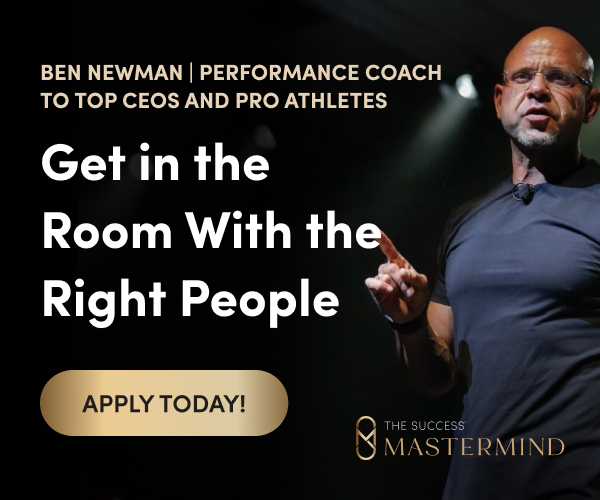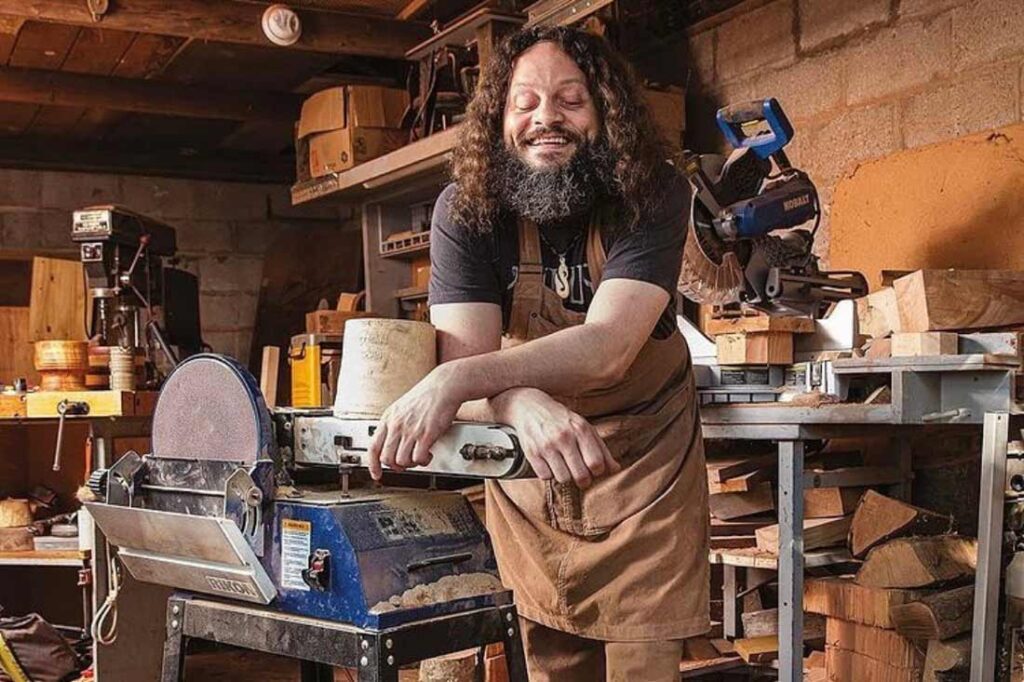In a TikTok video from August, woodworker John Furniss shows off an in-progress piece in his shop. It’s a big, gorgeous bowl, about 11 inches wide, into which he’s layered alternating pieces of yellowheart and black walnut wood. As his wife, Anni, films, he turns the bowl on a lathe, carving intricate ridges into the side. A few days later, he’ll share the finished product, oiled up and practically glowing in the sun, with its gorgeous grains on display.
Maybe none of this on its own sounds particularly remarkable to you—TikTok is full of creators and artists who share the process that goes into making their work, and much of it is as lovely as this. But John’s wooden creations are notable for another reason: The Washington state-based craftsman is blind.
How did ‘The Blind Woodsman’ go blind?
The journey that led John to become The Blind Woodsman, as he’s known today, was long, difficult and tragic. He grew up in a small town in Colorado “and I felt like I never really fit in, honestly,” he says. “I always kind of felt like I was on the fringes and not really understood. I had a lot of anxiety, and I started becoming very depressed pretty early.”
He estimates he was as young as 10 or 11 when the depression set in, and it was a secret he hid from everyone in his life. On April 10, 1998, it all came to a head: “I didn’t want to do it anymore; I didn’t want to live anymore,” he says. “And so I attempted suicide by shooting myself.”
The attempt didn’t take John’s life, but it did take his sight and sense of smell. And though he considers himself incredibly lucky, it also meant things would be very different for him. “I had to start a new life, almost. I had to learn how to be blind,” he says.
Incredibly, it turned out that wasn’t a terrible challenge. One month after leaving the hospital, John was able to replace the rear wheel-bearings in his old car without any help. “I grew up helping my dad work on cars and stuff, and so I remembered it,” he says simply. “I could just see it right in front of me in my mind.” Being without sight has its limitations, of course, but he says, “I adapted to it so well and so quickly that I genuinely feel like I am supposed to be blind.”
Honing his passion—and his craft
Which is not to say things were “easy” for him. For one, the question of work was an ongoing challenge.
“For blind people, most employment is in computers, in one way or another. And I don’t really do computers,” he explains. “I’m really good with my hands; I’m a great mechanic, I build things, fix things… and so that was a huge block in front of me because all the things that I’m good at are kind of dangerous.”
It wasn’t until 2005, when he was doing a vocational rehab program for the blind in Salt Lake City, that John discovered fine woodworking could be an option. He decided to take the woodworking class they offered, even though “honestly, I thought that was bonkers,” he laughs.
Eventually, he’d learn there’s a fairly large community of blind woodworkers—though it would still be some time until Furniss joined their ranks. Life took him next to the Emil Fries School of Piano Technology for the Blind in Vancouver, Washington. And though piano tuning wouldn’t turn out to be his passion, he did find something there he was passionate about. Someone, actually. It’s where he met Anni, who was at the school volunteering for a fundraiser in which local artists painted pianos.
“She was in the same workroom that I was, repairing a different piano, and I walked into the room, and just like an iron bar to a magnet, hand in the wet paint,” John chuckles.
It was Anni who, back in 2016, bought John the lathe that would become the instrument of his life’s work. It was also Anni who started posting John’s work on social media—first on Instagram—and almost immediately, the couple started hearing from people who were inspired by John’s story and who wanted to buy his creations.
The Blind Woodsman store: Furniss Studios
Today, the couple work together to run The Blind Woodsman website and social media accounts. “We make a good team,” Anni says. “I run the business, and I do my own art, and then John does his art.” For some time, they sold his creations at local festivals and fairs. Their TikTok account—which has amassed more than 1.9 million followers—changed everything.
“It changed our lives,” John says. “For one thing, even if we were doing the art fairs and holiday sales and stuff like that, it was a small, local customer base. And now, we sell nationally. Each piece goes to a different state, more often than not.”
(You have to be fast if you want to get an original Furniss, though. Each drop that hits the website sells out almost instantly.)
These days, watching the videos Anni posts online, you’d hardly think John’s lack of sight was ever a barrier for him. When I remark that he’s more coordinated and confident in the woodshop than I would be, he and Anni both laugh. “Me too,” Anni says.
“People will sometimes say, ‘Oh, I’m so sad that he can’t see his artwork,’ and John always likes to say, ‘Well, I see it before you do,’” she continues.
“I have an extremely vivid visual imagination,” John explains. “I like to say that I have a computer design program in my mind. When I make a project, I can see it right in front of me. I put the layers together; I change the colors, the design, whatever I want until I have my blueprint, so to speak. And so I see a finished piece before the wood even gets to the saw.”
Furniss’ story is for everyone
And John’s woodworking is far from the only thing the couple shares via TikTok. The account has also given them a platform to talk about blindness, mental health and the challenges John’s faced throughout his life, which are more universal than one might think. He and Anni have found that their message of acceptance and honesty around mental health, depression and anxiety has resonated with viewers everywhere.
“I don’t mind talking about it because there’s a stigma around it that is unexplainable but is so damaging,” John says. “It needs to be talked about; it needs to be brought out in the open, because mental health is health—no different than your heart or your lungs.”
The Blind Woodsman book is coming
In March 2024, John will expand upon his story, his struggles and passion for woodworking in a new book, The Blind Woodsman: One Man’s Journey to Find His Purpose on the Other Side of Darkness. And while he advocates for honesty about mental health, the process of writing the book—which he dictated to and co-wrote with Anni—was more challenging than he imagined going in.
“It was more intense than I thought it would be, honestly,” John says. “I had to very closely relive some pretty hard times in my life.”
Adds Anni: “There were stories I learned that John had never told before. He was like, ‘This is the only time I’m gonna be telling the story, in this book… it’s been a growth experience for both of us.”
As challenging as it was, John has no doubt it was the right thing to do. He knows it might sound hard to believe, but his blindness has given him a sense of purpose he couldn’t have imagined before. It helped him discover his passion. It led him to Anni. It gave him the following on TikTok to share his work, yes, but also a place to spread positivity and light, to share hope and wisdom about disability and bravery with millions of strangers around the world. And now he has the opportunity to pay it forward to other blind folks.
Grateful for life’s challenges
On the afternoon we spoke, John was preparing to help teach the first day of a new course on fine woodworking at the Washington State School for the Blind.
“The eventual goal of the program is to bring people from all across the country from blind schools that have fully equipped wood shops but no teachers, and we’re going to train teachers to go and be in those wood shops all over the country,” he says. He hopes he can bring the joy of woodworking to others who might find it as meaningful and life-changing as he did.
“It gave me something that I am naturally good at, that is productive in the end,” he says. “I never thought that I would not have to live on social security. I never thought that I would be able to find some sort of work that I could do well, and it would be gainful.”
Photo courtesy of John and Anni Furniss and Fox Chapel Publishing.










